Saint Himerius (Imerio, Imier) of Bosto is venerated as a pilgrim and martyr. He is venerated in the province of Varese jointly with Gemolus (Gemolo), who was martyred with him. (Some scholars believe that the two figures are the same man.) [1]
A tradition from the eleventh century holds that Himerius and Gemolus were Nordic [2] companions of a bishop who was travelling ad limina apostolorum –that is, on a pilgrimage to the sepulchres of St. Peter and St. Paul at Rome, i.e., to the Basilica of St. Peter and to the Basilica of Saint Paul Outside the Walls.
Himerius and Gemolus were killed during an assault on the bishop's entourage at Valganna by a band of men from Uboldo or Seprio. Gemolus was buried at Ganna, where an abbey dedicated to him arose in 1095, built by Atto (Attone), Ardericus (Arderico), Inghizo (Inghizone) with the permission of Arnulf III, Archbishop of Milan. [3]
Himerius, who escaped, eventually succumbed to his wounds at Varese, where he was buried in the church of San Michele at Bosto. The church was later named after him.
Another version of their story
A further elaboration states that Himerius and Gemolus pursued their attackers and that Gemolus was in fact the bishop's nephew. Camped for the night at Valganna, the bishop was robbed of his horse and other valuables by a band of brigands from Uboldo. Gemolus and Himerius pursued the brigands and caught up with them. Gemolus demanded the booty back in the name of God and the Apostles Peter and Paul. The brigands refused and cut his head off. They attacked Himerius, who escaped but later died. [4]
Gemolus survived the decapitation and, in the tradition of the cephalophores, collected his own head, climbed on horseback, and reunited with his uncle the bishop on a small mountain before he finally died. [4] The bishop buried him on that spot and erected a small church dedicated to Saint Michael, patron saint of the Lombards and protector of cemeteries. [4]

Saint Lawrence or Laurence was one of the seven deacons of the city of Rome under Pope Sixtus II who were martyred in the persecution of the Christians that the Roman Emperor Valerian ordered in 258.

Denis of Paris was a 3rd-century Christian martyr and saint. According to his hagiographies, he was bishop of Paris in the third century and, together with his companions Rusticus and Eleutherius, was martyred for his faith by decapitation. Some accounts placed this during Domitian's persecution and incorrectly identified St Denis of Paris with the Areopagite who was converted by Paul the Apostle and who served as the first bishop of Athens. Assuming Denis's historicity, it is now considered more likely that he suffered under the persecution of the emperor Decius shortly after AD 250.

Martial, called "the Apostle of the Gauls" or "the Apostle of Aquitaine", was the first bishop of Limoges. His feast day is 30 June.
Cyriacus, sometimes Anglicized as Cyriac, according to Christian tradition, is a Christian martyr who was killed in the Diocletianic Persecution. He is one of twenty-seven saints, most of them martyrs, who bear this name, of whom only seven are honoured by a specific mention of their names in the Roman Martyrology.

Victor the Moor was a native of Mauretania and a Christian martyr, according to tradition, and is venerated as a saint.
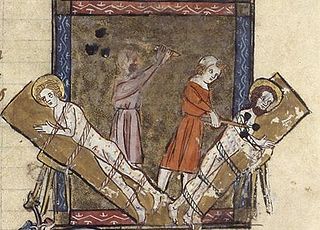
Gervasius and Protasius are venerated as Christian martyrs, probably of the 2nd century. They are the patron saints of Milan and of haymakers and are invoked for the discovery of thieves. Their feast day in the Latin Rite of the Catholic Church is 19 June, the day marking the translation of their relics. In the Eastern Orthodox Church and in the Eastern Rites of the Catholic Church, their feast takes place on 14 October (O.S.)/24 October (N.S.), the traditional day of their death. In Christian iconography their emblems are the scourge, the club and the sword.
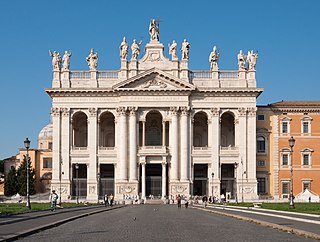
The Italian Catholic Church, or Catholic Church in Italy, is part of the worldwide Catholic Church in communion with the Pope in Rome, under the Conference of Italian Bishops. The pope serves also as Primate of Italy and Bishop of Rome. In addition to Italy, two other sovereign nations are included in Italian-based dioceses: San Marino and the Vatican City. There are 225 dioceses in the Catholic Church in Italy, see further in this article and in the article List of Catholic dioceses in Italy.
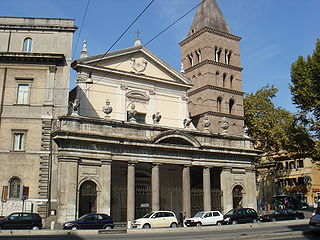
San Crisogono is a church in Rome dedicated to the martyr Saint Chrysogonus. It was one of the tituli, the first parish churches of Rome, and was probably built in the 4th century under Pope Sylvester I (314–335).

Saint Cucuphas is a martyr of Spain. His feast day is 25 July but in some areas it is celebrated on 27 July to avoid conflict with the important feast day of Santiago, the patron saint of Spain. His name is said to be of Phoenician origin with the meaning of "he who jokes, he who likes to joke."
Himeriusof Cremona, also known as Himerius of Amelia or Irnerius, was an Italian bishop. He is venerated as a saint by the Roman Catholic Church and Christian communities of Western Rite Orthodoxy.

SaintCaesarius of Terracina was a Christian martyr. The church of San Cesareo in Palatio in Rome bears his name.
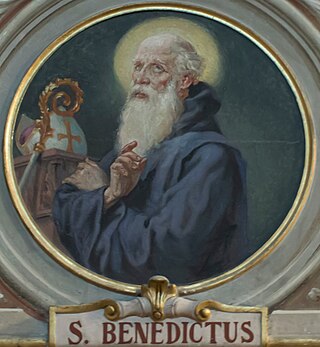
Benedict was Archbishop of Milan from c. 685–732. He is honoured as a saint in the Catholic and Eastern Orthodox Churches.

Isidoro Bianchi called da Campione was an Italian painter of the Baroque period.

Saint Aquilinus of Milan, also known as Aquilinus of Cologne, is venerated as a martyr by the Catholic Church.

Eleutherius (or Eleut erus or Eleftherios; sometimes called Liberalis or Liberator, the former transliterations and the latter translations of his and his mother Antia are venerated as Christian saints and martyrs in Greece and Albania.
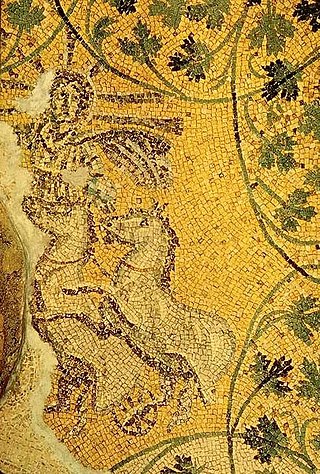
The Vatican Necropolis lies under the Vatican City, at depths varying between 5–12 metres below Saint Peter's Basilica. The Vatican sponsored archaeological excavations under Saint Peter's in the years 1940–1949 which revealed parts of a necropolis dating to Imperial times. The work was undertaken at the request of Pope Pius XI who wished to be buried as close as possible to Peter the Apostle. It is also home to the Tomb of the Julii, which has been dated to the third or fourth century. The necropolis was not originally one of the Catacombs of Rome, but an open-air cemetery with tombs and mausolea.

Vigilius of Trent is venerated as the patron saint and bishop of Trent. He should not be confused with the pope of the same name.

Anathalon was the first recorded Bishop of Milan and lived at the end 2nd-century or early 3rd-century. He is honoured as a Saint in the Catholic Church and his feast day is on September 25 in Milan. A late tradition made him the first bishop of Brescia where his feast day is celebrated on September 24.
Pietro Parenzo was a mayor of the Italian Comune of Orvieto during the 12th century. He was assassinated in 1199 by the adherents of Catharism and became honored as a saint and wonderworker after his death. He is the patron saint of the city of Orvieto.

The Cinque Vette Park is a natural park, established by the Region of Lombardy on 19 June 2017. The park is located in the north-eastern part of the Province of Varese, in the Italian region of Lombardy. It takes the name from the main geographic features located in the park, the five mountain peaks. The project was launched with the aim of the three local councils of to preserve a green area and make it available for touristic-sportive-cultural initiatives above 500 meters of altitude. The primary goal of the park is to encourage the discovery of the natural features of the north-eastern part of Varese, which offers panoramic view points and preserves historical aspects such as: the remains of the Cadorna Line; the ruins of the Castle of Cuasso al Monte; the Artistic village of Boarezzo; the Saint Gemolo Abbey; the Alpine Village of Mount Piambello; and, the Hospital of Cuasso Al Monte.
















